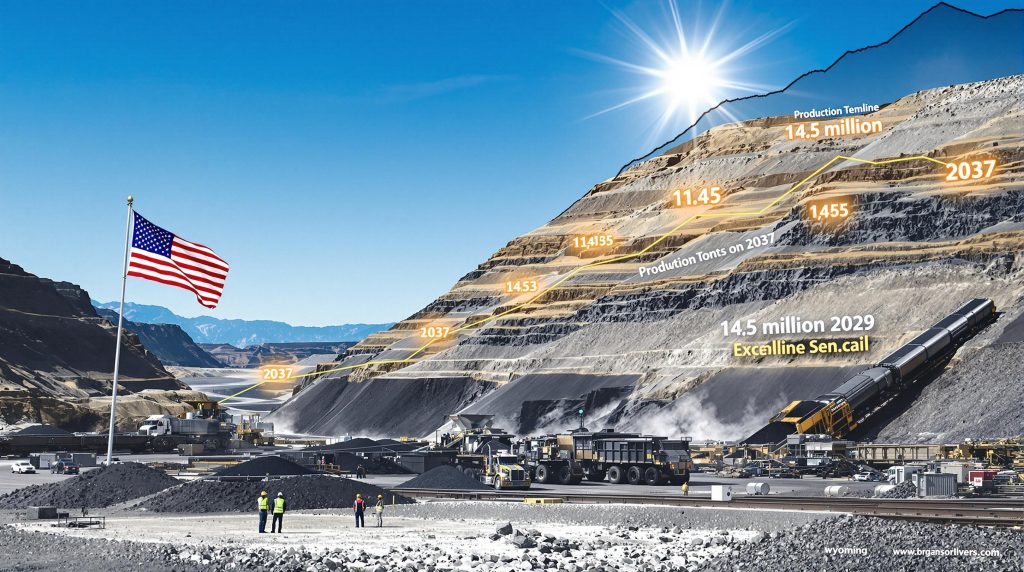The Interior Department Approves Mining Plan for Antelope Mine: Boosting US Coal Production
The Department of Interior has given its approval for a significant coal mining plan that will unlock 14.5 million tonnes of coal at Wyoming's Antelope Mine. This decision extends operations at one of America's crucial coal production sites while balancing economic needs with environmental considerations. The approval represents a major development for Wyoming's energy sector and demonstrates the current administration's support for domestic fossil fuel production amid ongoing coal supply challenges.
Understanding the Antelope Mine Expansion Project
The Antelope Mine expansion involves the West Antelope II South Tract Mining Plan Modification under Federal Coal Lease WYW-177903. This approval covers 857 federal acres in Converse County, Wyoming, within the resource-rich Powder River Basin. The decision effectively extends the mine's operational life until 2037, securing long-term production from this important energy asset.
The mine produces low-sulfur, low-ash subbituminous coal, which is valued for its cleaner burning properties compared to many other coal types. These characteristics make Antelope Mine's coal particularly desirable for power plants that must meet emissions standards while maintaining reliable electricity generation.
Strategically located in Wyoming's premier coal region, the Antelope Mine benefits from well-established infrastructure, including an on-site rail facility that enables efficient transportation to customers across the country. This logistical advantage helps maintain the mine's competitiveness in the evolving energy landscape.
Economic Impact on Wyoming Communities
The approved expansion helps secure 359 full-time jobs at the Antelope Mine, providing stable employment opportunities in a region where mining represents a significant portion of the local economy. These positions typically offer above-average wages and benefits compared to other industries in the area.
The economic benefits extend beyond direct employment at the mine. Local businesses, from equipment suppliers to service providers, benefit from the mine's continued operation. Additionally, tax revenue generated from coal production supports essential public services, including schools, infrastructure, and healthcare facilities in Converse and Campbell counties.
Secretary of the Interior Doug Burgum emphasized the broader implications: "The Trump administration is delivering on its promise to revitalize American coal and unleash our nation's energy potential. This decision boosts American jobs, enhances energy security, and supports communities that rely on coal to power their homes and economies."
For many Wyoming communities, coal mining represents more than just economic opportunity—it's part of the regional identity and cultural heritage that has sustained generations of families.
Environmental Assessment Process and Findings
Before approval, the Office of Surface Mining Reclamation and Enforcement conducted a comprehensive environmental review in accordance with the National Environmental Policy Act and other federal environmental regulations. This thorough assessment evaluated potential impacts on air quality, water resources, wildlife habitat, and cultural resources.
The review culminated in a "finding of no significant impact," determining that the proposed mining activities would not cause substantial adverse environmental effects. This finding was crucial for the project's advancement and reflects the mine's commitment to responsible resource development.
Modern mining operations at Antelope Mine incorporate various environmental safeguards, including:
- Progressive land reclamation that restores mined areas to productive use
- Water management systems to protect local aquifers and surface water
- Dust suppression measures to maintain air quality
- Wildlife protection protocols, particularly for species of concern
The mine operates under ongoing regulatory oversight to ensure compliance with all applicable environmental standards throughout its operational lifespan.
Alignment with Current Energy Policies
The approval aligns with several key federal energy policy objectives, particularly those outlined in the One Big Beautiful Bill Act. This legislation implemented changes to royalty payment structures for coal mined on federal land and increased land availability for resource extraction—policy shifts designed to enhance domestic energy production.
Acting Assistant Secretary for Land and Mineral Management Adam Suess highlighted the strategic importance of the decision: "As global instability continues to threaten energy markets, the need for reliable, domestic coal has never been clearer. This action underscores our commitment to common-sense permitting, environmental stewardship and energy dominance."
The administration has positioned coal as an essential component of the American energy mix, emphasizing its role in maintaining grid reliability during periods of peak demand or when renewable energy generation fluctuates. This perspective views coal as complementary to other energy sources rather than obsolete.
Recent executive mining permits have also aimed at supporting what proponents call "clean coal" technologies, which seek to reduce emissions through advanced combustion methods and carbon capture systems.
Other Coal Projects Moving Forward in 2025
The Antelope Mine approval is part of a broader pattern of coal project advancements in 2025. Another notable example is the Hurricane Creek Mining project in Tennessee, which received federal approval to produce up to 1.8 million tonnes of coal over a 10-year period.
Located on Bryson Mountain in Claiborne County, the Hurricane Creek project represents a smaller but still significant development in the Appalachian coal region. While the Powder River Basin and Appalachian coal fields produce different coal types for different markets, both regions have seen renewed regulatory support.
Other coal projects advancing in 2025 include:
- Permit extensions for existing operations reaching the end of their previously approved mining plans
- Infrastructure improvements at transportation hubs serving coal-producing regions
- Processing facility upgrades to enhance coal quality and reduce waste
These developments occur against the backdrop of a coal industry that has faced significant challenges in recent years but continues to adapt through operational efficiencies and market diversification.
Key Stakeholders in the Antelope Mine
The Antelope Mine is operated by Navajo Transitional Energy Company (NTEC), which employs conventional surface-mining techniques to extract coal efficiently. NTEC has positioned itself as a forward-thinking energy company that balances resource development with responsible environmental practices.
Surface mining at Antelope involves carefully removing overburden (the soil and rock above the coal seam), extracting the exposed coal, and then systematically reclaiming the land. This method allows for high recovery rates of the coal resource while minimizing waste.
Federal oversight comes primarily through the Department of the Interior and its OSMRE division, which monitors compliance with mining regulations and environmental standards. State agencies also play important roles in permitting, inspection, and ensuring adherence to local requirements.
The mine's customer base includes power utilities and industrial facilities that rely on consistent coal supplies to meet energy needs. These end-users represent another important stakeholder group with vested interests in the mine's continued operation.
The Significance of the Powder River Basin
The Powder River Basin stands as America's premier coal-producing region, spanning northeastern Wyoming and southeastern Montana. The basin's unique geology has created coal seams that are remarkably thick and relatively close to the surface, enabling cost-effective extraction compared to many other coal regions.
Coal from the Powder River Basin typically contains lower sulfur content than coal from other regions, making it valuable for power plants seeking to limit sulfur dioxide emissions. While the energy content per ton is typically lower than some other coal types, the favorable mining conditions often compensate for this difference.
The region's well-developed transportation infrastructure, particularly its extensive rail network, allows coal to be shipped efficiently to markets throughout the United States. This logistical advantage has been crucial to the basin's dominance in domestic coal production.
The Powder River Basin's role in American energy production extends beyond just volumetric significance—it represents a model of large-scale resource development that has evolved to balance economic production with environmental considerations through effective mine planning process.
Potential Energy Market Implications
The approval of the Antelope Mine plan helps secure a stable coal supply for power plants and industrial customers across the country. This reliability is particularly valued by grid operators who must maintain electricity availability regardless of weather conditions or time of day.
For power utilities with coal-fired generation assets, consistent access to fuel sources with predictable pricing helps with long-term planning and rate stability for electricity consumers. The extension of mine life at major production centers like Antelope provides greater certainty for these planning horizons.
The decision may also influence market dynamics between competing energy sources. While renewable energy and natural gas have gained market share, coal continues to play a significant role in the American energy mix, particularly during periods of high demand or extreme weather conditions.
Market Analysis Disclaimer: Future energy market conditions depend on numerous factors including regulatory changes, technological developments, and shifting consumption patterns. The observations presented here reflect current understanding but are not predictions or investment advice.
Frequently Asked Questions About the Antelope Mine Expansion
What conventional surface-mining techniques are used at Antelope Mine?
Antelope Mine utilizes a truck-and-shovel operation, where massive draglines and shovels remove overburden to expose coal seams. Large haul trucks then transport the coal to processing facilities. This method maximizes recovery while maintaining operational flexibility.
How does this decision affect carbon emissions targets?
The environmental assessment determined the project would not cause significant adverse environmental effects. However, coal combustion does produce carbon dioxide emissions. Proponents argue that technological innovations in coal utilization, including high-efficiency plants and potential carbon capture, can help address emissions concerns while maintaining energy security.
What economic benefits will local communities see from this approval?
Beyond preserving 359 full-time jobs, the continued operation of Antelope Mine generates tax revenue for local governments, supports secondary businesses in the supply chain, and contributes to community stability. The average mining wage in Wyoming significantly exceeds the state's median income, making these positions particularly valuable to the local economy.
How does the mine's production compare to other Powder River Basin operations?
While specific production rankings fluctuate annually, Antelope Mine consistently ranks among the significant coal producers in the Powder River Basin. The 14.5 million tonnes unlocked by this approval represents an important extension of the mine's resources, though some other basin operations have larger annual production volumes.
What reclamation plans are in place for mined areas?
Antelope Mine implements progressive reclamation, where disturbed land is restored concurrently with ongoing mining operations. This includes recontouring the landscape, replacing topsoil, and reestablishing native vegetation. Post-mining land uses typically include wildlife habitat and livestock grazing, with monitoring continuing for years after active mining to ensure successful restoration. The importance of mine reclamation importance cannot be overstated in maintaining environmental integrity.
Looking Ahead: The Future of Coal in America's Energy Landscape
The approval of the Antelope Mine expansion provides a window into the complex interplay between energy policy, economic considerations, and environmental stewardship. While the long-term trajectory of coal in America's energy mix remains subject to market forces and policy decisions, this approval demonstrates continued support for maintaining domestic production capacity.
For communities in Wyoming's coal country, the decision represents a welcome extension of economic opportunity. For energy markets, it signals continued availability of a fuel source valued for its reliability. And for policymakers, it reflects an approach that prioritizes domestic resource utilization while working within established environmental frameworks.
As America's energy landscape continues to evolve, decisions like the Antelope Mine approval will shape not just the future of coal production, but the broader conversation about energy security, economic development, and environmental responsibility as part of the ongoing mining industry evolution.
Want to Profit from the Next Major Mineral Discovery?
Discover high-potential ASX mining stocks before they skyrocket with Discovery Alert's proprietary Discovery IQ model, which delivers real-time notifications of significant mineral discoveries as they're announced. Explore why historic discoveries have generated substantial returns by visiting Discovery Alert's dedicated discoveries page and position yourself ahead of the market with actionable insights.




